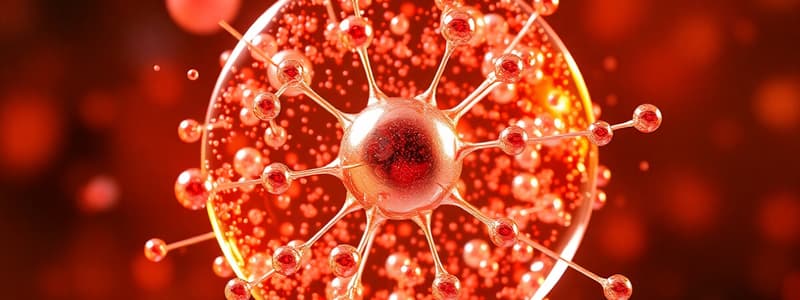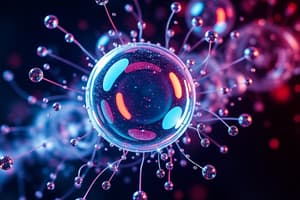Podcast
Questions and Answers
What is the primary concept of the Particle Theory?
What is the primary concept of the Particle Theory?
- Matter consists of tiny, discrete particles in constant motion. (correct)
- All matter is composed of large, fixed components.
- Matter's behavior is independent of temperature.
- Particles are only present in solids and liquids.
How does the arrangement of particles differ in solids compared to gases?
How does the arrangement of particles differ in solids compared to gases?
- Particles in solids are tightly packed and vibrate in place. (correct)
- Particles in solids move rapidly with significant space in between.
- Particles in solids have no movement at all.
- Particles in solids are spread out and move freely.
What type of particles can matter consist of?
What type of particles can matter consist of?
- Ions and pure substances only.
- Elements and mixtures only.
- Atoms, molecules, and ions. (correct)
- Atoms and compounds only.
What role does particle movement play in heat conduction?
What role does particle movement play in heat conduction?
Which of the following correctly describes the physical characteristics of liquids?
Which of the following correctly describes the physical characteristics of liquids?
The Particle Theory helps to explain which of the following phenomena?
The Particle Theory helps to explain which of the following phenomena?
Which statement about the implications of the Particle Theory is true?
Which statement about the implications of the Particle Theory is true?
What does the Particle Theory suggest about the behavior of particles in gases?
What does the Particle Theory suggest about the behavior of particles in gases?
What describes the arrangement of particles in a solid?
What describes the arrangement of particles in a solid?
How is the shape of a liquid characterized?
How is the shape of a liquid characterized?
Which of the following statements about gases is true?
Which of the following statements about gases is true?
What distinguishes pure substances from mixtures?
What distinguishes pure substances from mixtures?
Which of the following is a characteristic of heterogeneous mixtures?
Which of the following is a characteristic of heterogeneous mixtures?
What term is used for the substance that is dissolved in a solution?
What term is used for the substance that is dissolved in a solution?
In the context of solutions, what does molarity measure?
In the context of solutions, what does molarity measure?
Which method would be suitable for separating a mixture using boiling point differences?
Which method would be suitable for separating a mixture using boiling point differences?
What happens to a saturated solution when additional solute is added?
What happens to a saturated solution when additional solute is added?
Why is understanding the properties of mixtures crucial for industries?
Why is understanding the properties of mixtures crucial for industries?
Flashcards
Particle Theory
Particle Theory
The idea that all matter is made up of tiny, constantly moving particles.
Atom
Atom
The smallest unit of an element that retains the chemical properties of that element.
Molecule
Molecule
Two or more atoms chemically bonded together.
Ion
Ion
Signup and view all the flashcards
Solid
Solid
Signup and view all the flashcards
Liquid
Liquid
Signup and view all the flashcards
Gas
Gas
Signup and view all the flashcards
Properties of Matter
Properties of Matter
Signup and view all the flashcards
Chemistry
Chemistry
Signup and view all the flashcards
Element
Element
Signup and view all the flashcards
Compound
Compound
Signup and view all the flashcards
Pure Substance
Pure Substance
Signup and view all the flashcards
Mixture
Mixture
Signup and view all the flashcards
Homogeneous Mixture
Homogeneous Mixture
Signup and view all the flashcards
Heterogeneous Mixture
Heterogeneous Mixture
Signup and view all the flashcards
Concentration
Concentration
Signup and view all the flashcards
Study Notes
Particle Theory
- All matter is composed of tiny, discrete particles in constant motion.
- Particles can be atoms, molecules, or ions.
- Particle arrangement and movement determine matter's state and properties.
- Particle movement explains phenomena like heat transfer and state changes.
- The theory is foundational to understanding chemical reactions and physical transformations.
States of Matter
- Matter exists in three main states: solid, liquid, and gas.
- Solid: Particles are tightly packed, have a fixed arrangement, low kinetic energy, and strong intermolecular forces. They have a definite shape and volume.
- Liquid: Particles are closely packed but can move past each other, have medium kinetic energy, and moderate intermolecular forces. They have a definite volume but take the shape of their container.
- Gas: Particles are far apart, have high kinetic energy, and weak intermolecular forces. They have no definite shape or volume and fill their container.
Comparison of States
| Property | Solid | Liquid | Gas |
|---|---|---|---|
| Particle Arrangement | Closely packed, fixed | Closely packed, mobile | Far apart, random |
| Kinetic Energy | Low | Medium | High |
| Intermolecular Forces | Strong | Moderate | Weak |
| Shape | Definite | Indefinite | Indefinite |
| Volume | Definite | Definite | Indefinite |
Pure Substances and Mixtures
- Pure Substances: Composed of one type of particle (atom or molecule), have a fixed composition, and cannot be separated physically. Examples include iron, gold, water, and carbon dioxide.
- Mixtures: Composed of two or more pure substances not chemically combined, can be separated physically, and have variable compositions. Examples include saltwater, air, and alloys.
Homogeneous and Heterogeneous Mixtures
- Homogeneous Mixtures (Solutions): Uniform composition throughout, components cannot be visually distinguished. Examples include saltwater, alcohol in water, and air.
- Heterogeneous Mixtures (Mechanical Mixtures): Non-uniform composition, distinct phases or components can be visually distinguished. Examples include sand in water, oil and water, and trail mix.
Solutes, Solvents, and Concentration
- Solute: Substance dissolved in a solvent (minor component).
- Solvent: Substance dissolving the solute (major component).
- Concentration: Amount of solute in a given amount of solution, expressed as molarity, molality, or mole fraction.
Saturated Solutions and Solubility
- Saturated Solution: Contains the maximum amount of solute that can dissolve at a given temperature.
- Solubility: Maximum amount of solute that can dissolve in a given solvent at a specific temperature. Solubility changes with temperature and solute/solvent nature.
Separating Mechanical Mixtures
- Physical separation techniques include filtration, distillation, chromatography, and centrifugation to isolate components based on differences in properties like boiling point, density, or particle size.
Mixtures in Industry
- Mixtures are essential in various industries like metal production (alloys), fuel production (gasoline), manufacturing (paints, coatings, pharmaceuticals, fertilizers).
Studying That Suits You
Use AI to generate personalized quizzes and flashcards to suit your learning preferences.



